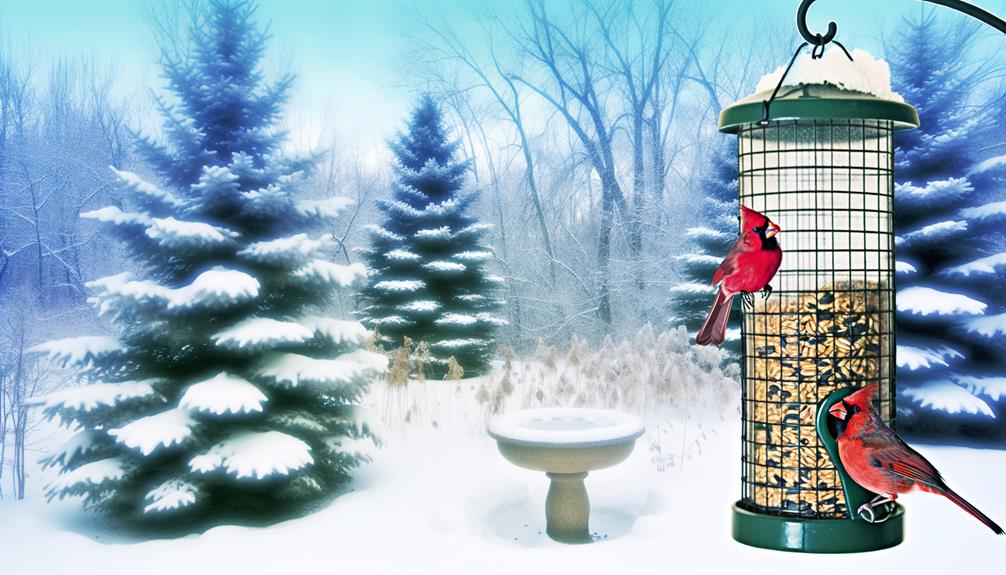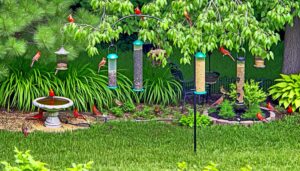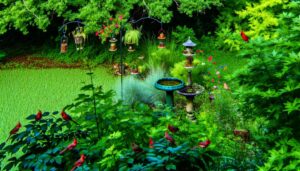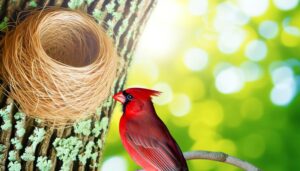3 Essential Tips to Attract Cardinals This Winter
Attracting cardinals in winter involves several precise strategies. Start with sturdy platform or hopper feeders placed at 5-6 feet high to protect them from predators and the elements.
Use seeds rich in oils and proteins like sunflower and safflower seeds. Heated bird baths provide essential hydration; make sure they remain ice-free.
Plant dense, evergreen shrubs and provide nesting materials like cotton and wool to offer shelter. Position feeders near dense foliage and install predator guards.
By tailoring your yard to their specific needs, you create a haven for cardinals. There's more to uncover for creating an ideal winter habitat for these vibrant birds.

Key Takeaways
- Use sturdy, spacious platform or hopper feeders positioned at 5-6 feet height for cardinals.
- Provide high oil content sunflower seeds, safflower seeds, and peanuts to attract cardinals.
- Install heated bird baths and maintain ice-free, shallow water basins for hydration.
- Plant dense native shrubs and create brush piles for shelter and nesting.
- Offer nesting materials like cotton, wool, and jute twine near shrubs for protection.
Choose the Right Feeders
Selecting the appropriate feeders is crucial for attracting cardinals in winter, as these birds prefer sturdy, spacious designs that can accommodate their size and feeding habits. You should consider platform feeders or hopper feeders, both of which provide ample space for cardinals to perch comfortably.
Research suggests cardinals are less likely to visit feeders that are too small or unstable. Make sure the feeders are constructed from durable materials like metal or high-quality plastic to withstand harsh winter conditions.
Position the feeders at a height of 5-6 feet to offer cardinals a safe feeding environment, away from ground predators. Additionally, incorporating a roof or cover on the feeder will protect the seed from snow and ice, preserving its freshness and appeal.
Select Cardinal-Friendly Seeds
To attract cardinals effectively, you'll need to fill your feeders with seeds that specifically appeal to their dietary preferences, such as sunflower seeds, safflower seeds, and peanuts. Research indicates these seeds provide ideal nutrition and energy, essential during the winter months. Sunflower seeds, particularly black-oil variants, have high oil content, enhancing calorie intake. Safflower seeds are favored due to their tough shells, deterring other birds and ensuring cardinals get their share. Peanuts, whether whole or shelled, offer protein and fat necessary for cold weather survival.
| Seed Type | Nutritional Benefits | Other Birds Deterred |
|---|---|---|
| Sunflower Seeds | High oil content | No |
| Safflower Seeds | Tough shell, high protein | Yes |
| Peanuts | Rich in fats and protein | No |
Provide Fresh Water
To attract cardinals during winter, you'll need to address their water needs by incorporating heated bird baths.
Ensuring daily water changes prevents contamination and supports the birds' hydration.
Employing ice-free solutions is essential to maintain accessibility, as cardinals rely on consistent water sources in colder months.
Heated Bird Baths
Heated bird baths, essential for providing fresh water during frigid months, guarantee cardinals have consistent access to hydration when natural sources are frozen. These devices maintain water temperatures above freezing by utilizing thermostatic control mechanisms, ensuring water remains thawed.
Research shows that cardinals are more likely to frequent areas where reliable water sources exist. Position your heated bird bath in a sheltered location to minimize heat loss and exposure to wind. Opt for models with built-in, grounded extensions to prevent electrical hazards.
Observations indicate that cardinals are drawn to shallow basins, around two inches deep. By implementing a heated bird bath, you directly support cardinals' physiological needs, promoting their survival and well-being during harsh winter conditions.
Daily Water Changes
Maintaining a heated bird bath is just part of the equation; ensuring daily water changes keeps the supply fresh, preventing the buildup of contaminants and offering cardinals the clean hydration they require.
Regular replacement of water mitigates the risk of algae growth and bacterial proliferation, important for avian health. Observational studies indicate that cardinals, like many bird species, prefer clean, fresh water sources, particularly in winter when natural supplies may be scarce.
Ice-Free Solutions
During harsh winter months, maintaining your water sources ice-free is important for attracting cardinals, as they require consistent access to liquid water for hydration. You can use heated bird baths to keep the water temperature above freezing.
Research shows that thermostatically controlled bird baths, which activate only when temperatures drop, are highly efficient. Observations indicate cardinals prefer shallow water no deeper than 2 inches.
Place bird baths in sheltered areas to minimize heat loss and wind exposure. Insulated containers or solar-powered heaters are additional solutions.
Consistently monitor and refill water sources to ensure availability. Providing fresh, unfrozen water not only supports cardinals but also benefits other winter-resident avian species, thereby fostering a vibrant, thriving ecosystem in your backyard.
Install Shelter Options
To attract cardinals during winter, you should prioritize installing shelter options like dense shrub planting and strategically placed birdhouses.
Research indicates that cardinals prefer evergreen shrubs for their dense foliage, which provides protection from predators and harsh weather.
Additionally, placing birdhouses at heights of 5-15 feet can offer cardinals safe nesting sites, enhancing their winter habitat.
Dense Shrub Planting
Planting thick shrubs like juniper and dogwood provides essential shelter for cardinals, particularly during harsh winter conditions. These shrubs create protective microhabitats, shielding cardinals from predators and harsh weather.
Research indicates that cardinals prefer evergreen shrubs for their year-round foliage, which offers continuous cover. Observational studies have shown that dense plantings reduce wind chill, helping birds maintain body heat.
To maximize shelter effectiveness, plant shrubs in clusters, creating a thicket-like environment. This configuration mimics their natural habitat, enhancing cardinals' sense of security. Ensure varied shrub heights to accommodate different perching and nesting preferences.
Birdhouse Placement Tips
Positioning birdhouses strategically in your yard can greatly enhance cardinals' winter survival by providing them with additional shelter options. To optimize placement, make sure you follow these evidence-based guidelines:
- Height: Mount birdhouses at a height of 5-15 feet to protect cardinals from ground predators while maintaining easy access.
- Orientation: Face the birdhouse entrance away from prevailing winds to minimize exposure to harsh weather conditions, enhancing thermal retention.
- Proximity: Place birdhouses near dense shrubs or evergreen trees. This not only offers additional shelter but also provides a quick escape route from predators.
Research shows that well-placed birdhouses can significantly reduce stress and increase the likelihood of cardinals thriving during winter months. Your attention to these details demonstrates a commitment to serving and safeguarding these vibrant birds.
Plant Native Shrubs
Native shrubs like dogwood and viburnum provide vital cover and food sources for cardinals during the winter months. These shrubs' dense branches offer shelter from harsh weather and predators.
Research indicates that cardinals prefer habitats with high shrub density, as it enhances their survival rates. Planting native shrubs guarantees the availability of fruits and berries, which are essential during food-scarce periods.
You'll find that species such as the American cranberrybush and winterberry not only attract cardinals but also support local ecosystems. It's important to plant a variety of shrubs to create a layered habitat. This approach increases biodiversity and provides a sustainable environment for cardinals and other wildlife.
Create Brush Piles
Another effective strategy to enhance cardinal habitats is to create brush piles. Brush piles offer critical shelter from predators and harsh weather conditions, mimicking natural forest debris. They provide cardinals with a safe haven and an ideal foraging ground. Research indicates that brush piles can notably increase cardinal survival rates by providing essential cover.
Constructing a brush pile is straightforward:
- Base Layer: Start with larger logs to create a sturdy foundation.
- Mid Layer: Add medium-sized branches to build up the structure and create pockets for shelter.
- Top Layer: Finish with smaller twigs and leaves to offer insulation and camouflage.
Offer Nesting Materials
You should provide natural fiber options like cotton, wool, and small twigs to support cardinal nesting. Place these materials in easily accessible locations such as low branches or open containers to facilitate their use.
Research indicates that strategic placement enhances the likelihood of cardinals adopting your site for nesting.
Natural Fiber Options
Providing nesting materials like natural fibers can greatly enhance your backyard's appeal to cardinals during the winter months, as research indicates that these birds prefer organic, biodegradable options for constructing their nests. By offering an array of natural fibers, you support the cardinals' nesting needs, which is vital for their winter survival and comfort.
Studies show that cardinals are particularly attracted to:
- Cotton fibers – Soft and pliable, ideal for insulation.
- Wool – Retains heat effectively, providing warmth during cold nights.
- Jute twine – Durable and flexible, perfect for structural support.
These materials emulate the natural environment cardinals seek, enhancing their nesting experience and fostering a sustainable habitat. Observing these feathered friends thrive can be immensely rewarding for you and beneficial for the ecosystem.
Placement and Accessibility
Strategically situating nesting materials in sheltered, accessible locations within your backyard will optimize their usefulness for cardinals during the winter months. Position materials such as twigs, grasses, and pine needles near dense shrubs or coniferous trees. These areas offer natural windbreaks and camouflage, enhancing protection from predators and harsh weather.
Research indicates that cardinals prefer low to mid-height placements, approximately 4-6 feet above ground. Ensure that these sites are easily reachable for regular replenishment. Observations suggest that cardinals frequently revisit reliable sources, so consistent availability is essential.
Utilize feeders and platforms to keep nesting materials dry and elevated. By thoughtfully situating these resources, you'll create an inviting habitat, effectively supporting cardinals' winter nesting behaviors and contributing to their overall wellbeing.
Maintain a Safe Environment
Ensuring a safe environment for cardinals in winter involves minimizing exposure to predators and harsh weather conditions through careful placement of feeders and shelters.
To enhance their safety, consider the following:
- Position feeders near dense shrubs: Shrubs provide cardinals with quick escape routes from predators. Research shows that cardinals prefer areas with nearby cover for protection.
- Install predator guards: Utilize baffles or other deterrents on feeder poles to prevent access by squirrels and larger predatory birds. Studies indicate that such measures notably reduce predation risks.
- Create windbreaks: Place shelters and feeders in locations shielded from prevailing winds. Observations confirm that cardinals are more likely to frequent areas offering protection from harsh weather, ensuring their energy conservation during winter months.
Use Heated Birdbaths
Incorporating heated birdbaths into your winter garden ensures cardinals have access to unfrozen water, which is crucial for their survival and hydration. Research indicates that cardinals, like many avian species, require consistent access to water for drinking and bathing, even in freezing temperatures. Heated birdbaths prevent ice formation, guaranteeing water availability.
| Feature | Benefit |
|---|---|
| Thermostatically controlled | Maintains ideal water temperature |
| Safe materials | Prevents harmful chemical leaching |
| Elevated design | Reduces predator risk |
| Energy-efficient models | Minimizes electricity use |
Observations show cardinals frequently visit heated birdbaths, demonstrating increased hydration levels and overall health. By incorporating these birdbaths, you fulfill the cardinals' hydration needs and contribute to their winter survival.
Avoid Harmful Chemicals
Using harmful chemicals in your garden or bird feeders can pose significant risks to cardinals' health and well-being. These substances can lead to toxicity and disrupt their natural foraging behaviors.
Here are three steps to guarantee a safe environment for cardinals:
- Opt for Organic Pesticides: Use natural pest control methods like neem oil or diatomaceous earth to eliminate harmful insects without risking the birds' health.
- Avoid Chemical Fertilizers: Choose compost or organic fertilizers to nourish your plants, ensuring the soil remains free from harmful synthetic compounds.
- Check Birdseed Ingredients: Verify that your birdseed is free from additives and preservatives, which can be detrimental to cardinals.
Keep Feeders Clean
Regularly tidying your bird feeders is crucial to preventing the spread of diseases and guaranteeing cardinals have a safe feeding environment. Research indicates that unclean feeders can harbor pathogens like Salmonella and Mycoplasma, detrimental to avian populations.
To serve cardinals effectively, clean feeders with a 10% bleach solution, rinsing thoroughly to eliminate residues. Observations show that cleaning every two weeks during winter minimizes contamination risks. Additionally, make sure feeders are dry before refilling to prevent mold growth.
Dispose of any wet or moldy seed immediately, as it can cause respiratory issues in birds. By maintaining clean feeders, you're not only attracting cardinals but also contributing to their overall well-being and the health of your backyard ecosystem.
Conclusion
To attract cardinals in winter, you'll need to take a multi-faceted approach. Research shows cardinals prefer feeders stocked with black oil sunflower seeds.
Don't forget to provide fresh water and heated birdbaths, as dehydration is a risk even in cold weather.
Offer native shrubs for shelter, and maintain a safe environment by avoiding harmful chemicals.
By keeping feeders clean and strategically placed, you're more likely to witness the vibrant red of these birds against the snowy landscape.






